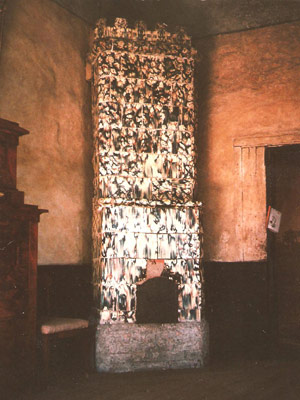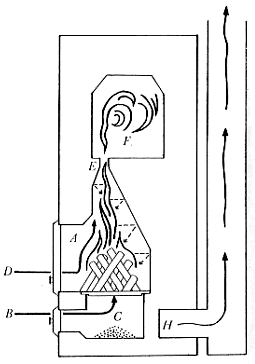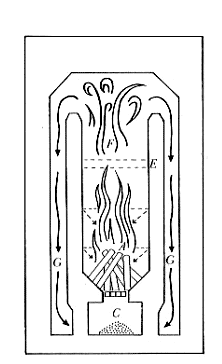Used through North East Europe, masonry heaters are known by a variety of names, Russian stoves, tiled stoves and Finnish fireplaces, being the most common.
Though they all used the same principals of secondary combustion, and thermal storage within their mass, there were many distinct variations, which developed as a result of different local requirements, availability of resources and the traditional layout of dwellings.
Around the beginning of the 18th century, North Eastern Europe and Scandinavia experienced a domestic wood shortage. It was partially in answer to this scarcity that existing forms of masonry fireplaces were modified to give greater combustion efficiency.
 |
A late eighteenth century Swedish Kachelung. Smalland 1993 |
Many North East European countries developed relatively efficient masonry heaters though it was the Swedes who developed the down-draught contra-flow system around which both modern Swedish and Finnish heaters have evolved.
Today most North American stove masons build Finnish Taaka, as they are the most appropriate to the open plan layout of modern homes. Occasionally Swedish Kachelung, German Kachelofen, and Russian Groop Ka are built for clients with a specific interest in, or connection to these stoves.
The most important principal regarding masonry heaters is that they must be functional and that any possible aesthetic variation must be a secondary consideration.
The masonry heater fulfills three main requirements:
To reach temperatures high enough to achieve the total combustion of wood (600C/ 900F) a fast aggressive combustion is necessary.
Side Elevation (cross section) |
Front Elevation (cross section)
|
The dimensions of the flues in this contra-flow system are crucial. They must run through the heater for the longest distance possible. This allows a maximum transfer of heat to the masonry before the hot air enters the chimney. The flues must not be too long however as this would restrict the draft through the system making an aggressive combustion impossible, and run the risk of a week draw.
Because masonry heaters transfer heat in a very subtle way, the masonry is only ever warm to the touch, there are no hot surfaces or naked flames to cause personal burns. The heater radiates heat all day and night from just two fires per day each lasting about 1 1/2 hour. Once lit, the fire burns until it dies so it is not necessary to reload the firebox thus eliminating the risk of falling embers and handling hot metal parts. There is only fire in the system for 1 or 2 hours per day, yet it heats evenly 24 hours per day.
Due to the high combustion temperatures and near total combustion of fuel there is no build up of creosote in the chimney and flues, making a chimney fire practically impossible. The chimney will smoke for the first 5 or 10 minutes after lighting but once the fire is established, full combustion is obtained and all combustible gases and any deposited creosote will be burnt. As there is no smoke leaving the chimney and the fire does not burn continuously all day, masonry heaters produce much less air pollution than conventional wood burning appliances.
Firing the heater only twice a day means that much less wood is used. In addition, since thin pieces of wood can be burnt, it is possible to buy cheaper limb wood, thus using wood cuts that are of little use to most people, and reducing the burden on what should be a renewable resource.
Masonry heaters produce heat both by radiation and passive convection. Once fired the mass of the heater will emit a constant level of heat for up to 8 hours. The heat is gently convected and radiated from the masonry to the floors, walls, ceiling and the furniture, resulting in high surface temperatures and cool air temperatures. In comparison, conventional heating systems heat the air rather than the surfaces. It is advantageous if the air we breathe is cooler than the furniture we sit on and the floors we walk on.
Dwelling Cross section.The centrally located heater and chimney heat via radiation (dotted lines) and by passive convection (solid lines). Radiant heat is emitted directly from the surfaces of the heater, and from the chimney both on lower and upper floors. Passive convection occurs when the air close to the surface of the heater becomes warm and starts to rise up the face of the heater, becoming warmer as it rises. These passive convectional currents rise up to the ceiling, and travel, across the ceiling, to the extremities of the dwelling before cooling slightly, descending the walls, finally rolling across the floor back towards the heater. Where there are openings, leading to a second floor, such as a stairwell, these currents rise up into the second floor and repeat the process explained above. |
Because the exterior masonry never becomes hot, only warm, there is no scorching of dust particles, enhancing the chance of respiratory irritation. Furthermore, as masonry heaters heat by gentle convection and radiation, no aggressive conventional air currents are produced to circulate dust and fungal spores, which even unscorched, can contribute to respiratory ailments.
Finally, imbalance of the air ionisation caused in part by hot dry heating systems is suspected as promoting ailments of the circulatory system. Due to the subtle way in which masonry heaters give off their heat, they only minimally disturb the balance of ions in the home atmosphere.
Cookstoves work on the same principles as heaters. Gases from the fire after passing beneath the hot plates and around the oven are circulated through a system of flues in the masonry before entering the chimney. Unlike heaters cookstoves do not have a secondary combustion chamber and though burning relatively aggressively, do not achieve full combustion and so produce smoke.
The cast iron top (hot plates) of the cookstove becomes hot rapidly but soon loses its heat once the fire has gone out. The masonry and the oven however will remain warm for hours.
Many people who have a cookstove and heater in the same open plan living area use the cookstove as a source of instant heat when the weather may not be cold enough to warrant firing the heater.
Masonry cookstoves are built to the same design as traditional cookstoves used in homes throughout Finland.
All masonry heaters should have a masonry chimney which can be located at the
rear or on either side of the heater.
Cookstoves may share the same flue as the heater or can use separate flues or
even separate chimneys.
See Services: Details and Dimensions
Since being introduced to North America 20 years ago, most masonry heaters have
been hand built by an extremely small group of specialized masons, most of who
are extremely passionate about their trade.
Heaters are built brick by brick including the refractory core and inner walls.
Building a heater by hands involves a high level of precision and knowledge of
materials and is a trade in its own rite.
Several European companies now produce pre-fabricated heaters which are delivered to the construction site in the form of factory built modules. They are then assembled by trained personnel in a fraction of the time it takes to construct a custom-built brick heater.
The Finnish company Tulikivi produces a wide range of modular heaters and cook stoves. And Krownspisen of Emmaboda, Sweden specialises in modular versions of the traditional tiled heater or Kakelung.
In North America, Norbert Senf has designed his own modular heater "The Heat Kit" and Maine Wood Heat Co. produces its pre-fabricated core the "Albi Core" the latter is a partially pre-fabricated refractory core used on custom-built brick heaters with the intention of reducing construction time and enabling the inexperienced builder to assemble the normally complicated refractory core.
The Ontarian Company Tempcast produces a pre-fabricated core kit based on the traditional Finnish design. It contains 35 refractory modules and is marketed through North America.
The advantage of modular heaters, besides saving on construction time and causing minimal disruption during construction is that they can be installed by almost any experienced mason, or even the home builder.
Swedish Kakelugn were traditionally made using only three materials; clay, sand and water. Their interior walls consisted of factory produced glazed tiles while the firebox and inner flues were made from clay bricks layed in clay mortar.
The clay bricks of the original Kakelung were not very durable and so about every 15 to 20 years the whole Kakelung would be dismantled and then rebuilt using the original set of tiles. The clay mortar, used for its elasticity, unlike cement based mortar never set hard and so dismantling and rebuilding a Kakelung was a relatively straight-forward operation.
When Kakelung were seemingly made obsolete by the popularity of oil and gas heaters, the majority of them were destroyed or discarded. A certain number though were dismantled, their tiles numbered and then packed carefully into crates.
 |
A late nineteenth century Kachelung reassembled in a modern Swedish home. |
Now they are mostly bought for use in renovated buildings or by enthusiasts for whom their artistic value offsets their inefficiency.
Most original Kakelugn available today were made during the 19th century or the Art Nouveau and Art Deco periods of the early 20th century. They reflect the then current artistic trends in their overall shape, and the painted patterns of their tiles.
Original Kakelung were designed to heat a single room. Their relative inefficiency and the care needed in operating them is enough to discourage all but the most dedicated traditionalists.